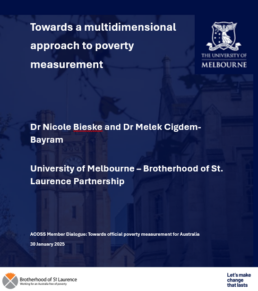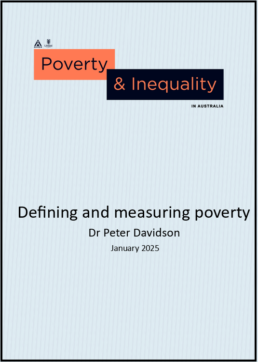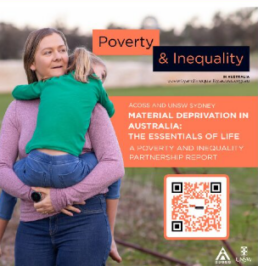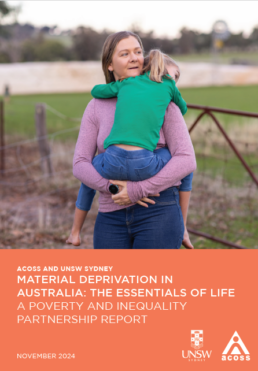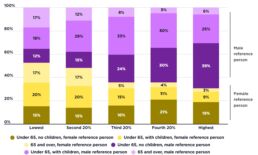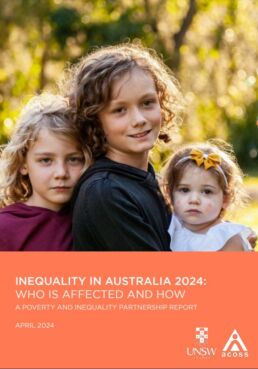People receiving JobSeeker five times more likely to experience multiple deprivation: New report
People receiving JobSeeker are around five times more likely to experience multiple deprivation than the general population, according to a new report by the Poverty and Inequality Partnership led by ACOSS and UNSW Sydney.
Material deprivation in Australia: the essentials of life found about one in two people relying on JobSeeker and one in three sole parents are experiencing multiple material deprivation, compared to about one in twelve people nationally.
Multiple material deprivation is when a person lacks two or more essential items because they can’t afford them. Examples include a decent and secure home, a yearly dental check-up and $500 in savings for emergencies.
The report found eight groups of people are particularly at high risk of multiple deprivation: people relying on JobSeeker Payment; Parenting Payment, Disability Support Pension or Youth Allowance, sole parent families, First Nations people, and those renting social housing or privately.
For example, more than one in three people relying on JobSeeker are deprived of having at least $500 in savings for an emergency, one in three can’t afford home contents insurance and one in five are deprived of dental treatment when they need it.
The report found:
- People on JobSeeker are around five times more likely to lack two or more essential items than the general population (45% vs 9%).
- People receiving a Parenting payment are around four times more likely to lack two or more essential items (38%).
- Sole parents (29%) and First Nations people (32%) are three times more likely to lack two or more essential items
- Private renters are twice as likely to experience ‘multiple deprivation’ compared with the general population (19%).
- People receiving JobSeeker are 14 times more likely to lack a substantial meal at least once a day; almost 9 times more likely to lack a mobile phone or a motor vehicle; and 8 times more likely to lack access to the internet at home or a washing machine
- 81% of people with incomes below the poverty line and experiencing multiple material deprivation have low wealth
- 50% of unemployed households experience multiple deprivation, lacking two or more essential items.
The report, using data from the Household, Income and Labour Dynamics in Australia Survey, identified 23 essential goods and services considered by a majority of people living in Australia as things that nobody should have to go without, and measured how many people lack those items because they cannot afford them.
The items which people on income support payments most often lack are protections against future risks including at least $500 in emergency savings, home contents insurance or comprehensive car insurance; items for children including new school clothes or a hobby or leisure activity; health items including dental treatment when needed; and getting together with friends or relatives at least once a month for a drink or meal.
| Percentage of people deprived of essential items by payment type | |||
| Essential item | JobSeeker Payment | Parenting Payment | Youth Allowance |
| $500 in savings | 36.6% | 39.0% | 15.9% |
| Home contents insurance | 38.3% | 31.6% | 22.2% |
| Dental treatment when needed | 18.5% | 16.1% | 10.6% |
| Comprehensive motor vehicle insurance | 22.3% | 20.0% | 11.4% |
| New school clothes for school-age children every year | 8.1% | 7.5% | N/A |
“People receiving income support are experiencing multiple material deprivation at rates that far exceed the general population,” said ACOSS CEO Dr Cassandra Goldie.
“This tells us that JobSeeker, Youth Allowance and related payments are so woefully low that people can’t afford the basic essentials of life.
“The extremely high rate of people with low wealth (81%) among people with incomes below the poverty line who are experiencing multiple deprivation shows the important role that wealth plays as a protection against poverty.
“In its upcoming Budget, the Federal Government must raise income support payments to liveable levels, fix employment services, boost social housing and enact a jobs, services and training plan to reduce long-term unemployment. These policies will go a long way to reducing poverty and material deprivation across Australia.”
Melika, who lives in Lake Macquarie and receives the Single Parenting Payment, has put off essential medical appointments for more than a year because she “simply can’t afford them. I need these tests due to the toll poverty has taken on my health. Medicare doesn’t cover the costs and without support, I have no way to access the care I need,” Melika said.
“Living in social housing has brought new challenges… I can’t afford to stay connected with friends and I ignore my electricity bills. This isn’t just financial deprivation, it’s an ongoing struggle that affects every part of my life.”
Lead author of the report, Dr Yuvisthi Naidoo, UNSW Senior Research Fellow, said: “This research highlights that Australia’s income support system is failing to provide adequate protection against deprivation. Income support payment levels are set assuming that everyone has access to universal healthcare and adequate social services - but the high rates of people lacking dental and medical care shows that assumption is flawed.”
Jesuit Social Services CEO Julie Edwards said: “Through our programs supporting people and communities on the margins, we know that people receiving income support are often having to make extraordinarily difficult decisions about choosing whether to pay for medication or their children’s school supplies. This report puts in stark focus the material deprivations that people are experiencing every single day.
“We have long known that the income support system is inadequate and does not allow recipients to lead dignified lives - let alone during a cost-of-living crisis like we are currently in. We call on our political leaders to lift income support to allow recipients to live above the poverty line and increase their ability to afford access to essentials.”
Mission Australia CEO, Sharon Callister said: "This report confirms what our frontline workers see daily: despite Australia’s wealth, too many people on the lowest incomes who rely on income support, or rent social housing, are struggling to afford life’s essentials and are living in deprivation.
“Homelessness and poverty are closely linked. Without urgent action, more people across Australia will be left behind and at risk of homelessness. Mission Australia calls for an increase in JobSeeker and other income support to $82 a day and a 60% boost to the maximum threshold of Commonwealth Rent Assistance. We also need a commitment to building one million new social and affordable homes over the next 20 years, alongside a $500 million Homelessness Prevention Transformation Fund. Now is the time for a long-term commitment to end homelessness and poverty in Australia.”
UNSW Vice-Chancellor and President Professor Attila Brungs said the report demonstrates the needs faced by a growing number of people in Australia.
“The core mission of an Australian university is contributing to a better society through our education, research and engagement on critical issues. At UNSW we believe it is critical that all parts of society benefit, and we want to help build a better, fairer and more equitable Australia,” he said.
“UNSW is very proud to partner with ACOSS to deliver the Poverty and Inequality report. The leading academics from UNSW who worked on this research have provided robust findings. They will help drive policies to address poverty and inequality more effectively, and help advance economic and social prosperity for all.”
JobSeeker is currently $56 a day. ACOSS wants it to match the pension rate of $82 per day.
Profile of each income group by gender of household reference person
Families with a female reference person generally have lower incomes than those with a male reference person. The two charts below show the profile of each income group by the gender of the household reference person.
2019-20
This chart shows that a clear majority (70%) of households in the highest 20% income group had a male reference person.
2017-18
This chart shows that the majority (71%) of households in the highest 20% income group had a male reference person.
New data shows wealth gap widening
New research by ACOSS and UNSW Sydney reveals the widening wealth gap between people with the most and least, even as income inequality slows.
The latest report from the Poverty and Inequality Partnership, Inequality in Australia 2024: Who is affected and how? shows the average household wealth of Australia’s highest 10% growing much faster than the lowest 60%, from $2.8 million to $5.2 million (an 84% increase) over the past 20 years. Meanwhile, the average wealth of the lowest 60% has risen from $222,000 to $343,000 (a 55% per cent increase).
Nearly half (45%) of the increase in household wealth since 2003 went to the highest 10% (those with at least $2.6 million) and half of this increase to wealthy older people (over 64 years).
Wealth inequality is also growing among households aged under 35, even though they hold just 5% of all wealth. The average wealth of the highest 10% rose from $928,000 to $2 million (an increase of 126%) since 2003. At the same time, the average wealth of the lowest 60% of younger households – largely excluded from home ownership – rose just $68,000 to $80,000 (39%).
The report also shows wage inequality falling between 2021 and 2023, when unemployment dropped below 4%. During that time, wages growth for the lowest 10% (up 4.9%) outpaced the highest 10% (up 3.3%).
But ACOSS CEO Cassandra Goldie warned that rising unemployment, driven by higher interest rates, would be disproportionately felt by people relying on income support as low as Jobseeker at $55 a day.
“These disturbing figures show that people with the lowest income and least wealth are being left behind by the increasing inequality in Australia,” she said.
“Without major reform to housing, superannuation tax breaks and income support, the divide between those with the most and those with the least will continue to deepen.
The fastest and most efficient way to support those worst affected by income inequality is by raising the rate of JobSeeker to at least the pension rate of $80 a day.
“Reducing tax concessions for negative gearing and capital gains, as well as superannuation, that speed wealth accumulation among the highest 10% and increase housing prices would help stem growth in wealth inequality.”
Scientia Professor Carla Treloar from UNSW Sydney said:
“This research shows that the main cause of income inequality is unequal distribution of earnings, through inequality of paid working hours and hourly wages.
“It shows, too, that the solid increase in employment over the past couple of years has reduced individual earnings inequality.
“The answers are clear – full employment reduces inequality. Increasing income support payments reduces inequality. Reducing those tax concessions that disproportionately benefit those with the most reduces inequality.”
UNSW Sydney Vice-Chancellor and President Professor Attila Brungs said:
“The Poverty and Inequality Partnership between ACOSS and UNSW draws on the strengths of both organisations to understand and address the drivers of poverty and inequality in Australia.
“Through high-quality research and advocacy, the Poverty and Inequality Partnership provides evidence-based insights that help focus the national attention on how we can do better for the millions of Australians who experience poverty and inequality.
“Highlighting where policies create unfair outcomes is important to drive positive change and create a more just and equitable society.”
Mission Australia CEO Sharon Callister said:
“The relentless growth in wealth inequality revealed in this report stands in sharp contrast to the level of income support many people have to rely on, especially the $55 a day JobSeeker Payment. It should be lifted to at least $80 a day. More people and families across Australia find themselves grappling to make ends meet, with fundamental necessities like a secure, safe home slipping further out of reach.
“These aren’t just statistics for Mission Australia; it's what our frontline staff witness every day - the faces of individuals and families struggling against the tide of inequality. We call for a more equitable Australia where everyone is afforded dignity and has the opportunity to thrive.”
Jesuit Social Services CEO Julie Edwards said:
“This research shows that wealth inequality across Australia has continued to increase over the past 20 years. At the same time, we are currently in the midst of a cost of living crisis that has compounded challenges for many of the people Jesuit Social Services works with. We call on our political leaders to urgently provide better support to people on the lowest incomes, including people receiving income support payments.
“Raising the rate of Jobseeker to at least $80 a day should be the starting point to begin lifting people on income support above the poverty line, which will ultimately help to prevent homelessness and give more people a chance to lead positive lives.”
Read the full report here: https://bit.ly/inequalityinaustralia24
Income inequality:
- The highest 10% of households by income take home an average of $5,248 after tax, more than two and a half times the middle 20% ($1,989) as well as six times the lowest 20% ($794).
- The main cause of income inequality is unequal distribution of earnings, driven by inequality of paid working hours and hourly wages.
- Lower income brackets are more likely to include people receiving Jobseeker and related payments, sole parents, families whose main income-earner is a woman and adult migrants born in non-English speaking countries.
- Income support and family payments reduce inequality by 9% and income tax by 29%.
See where you stand in the income spectrum with our income calculator, available at: https://bit.ly/4aRfK08
Wealth inequality:
- Nearly half of all wealth is held by the highest 10% of households, worth an average $5.2 million each. They hold 15 times’ the wealth of the lowest 60% ($343,000 per household).
- Over half of the wealth (53%) of older households was owned by one-sixth of older people. They had an average wealth of $5.6 million, comprise 4% of all households but hold 18% of all wealth.
- The average over-65 household is 25% wealthier (with $1.58 million) than the average middle-aged household (with $1.26 million) and almost four times as wealthy as the average under-35 household (with $410,000).
See where you stand in the wealth spectrum with our wealth calculator, available at: https://bit.ly/3xsVnb5
Community attitudes: I would be able to live on the current rate of unemployment payment
This chart shows the responses in our Community attitudes towards poverty and inequality survey 2023 to the question whether respondents would be able to live on the current rate of unemployment payment
It shows that 58% of people in Australia said they could not live on that amount and 19% were unsure. Only 23% agreed they could live on the current rate.
Read the full report here: https://bit.ly/communityattitudes2023
Community attitudes: Unemployment payments should be enough for people to be able to see the doctor when they need
This chart shows the responses in our Community attitudes towards poverty and inequality survey 2023 to the idea that Unemployment payments should be enough for people to be able to see the doctor when they need.
It shows that 84% of people in Australia agreed that unemployment payments should be enough for people to be able to see the doctor when they need.
Read the full report here: https://bit.ly/communityattitudes2023
